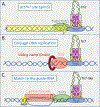Targeted transposition with Tn7 elements: safe sites, mobile plasmids, CRISPR/Cas and beyond
- PMID: 31502713
- PMCID: PMC6904524
- DOI: 10.1111/mmi.14383
Targeted transposition with Tn7 elements: safe sites, mobile plasmids, CRISPR/Cas and beyond
Abstract
Transposon Tn7 is notable for the control it exercises over where transposition events are directed. One Tn7 integration pathways recognizes a highly conserved attachment (att) site in the chromosome, while a second pathway specifically recognizes mobile plasmids that facilitate transfer of the element to new hosts. In this review, I discuss newly discovered families of Tn7-like elements with different targeting pathways. Perhaps the most exciting examples are multiple instances where Tn7-like elements have repurposed CRISPR/Cas systems. In these cases, the CRISPR/Cas systems have lost their canonical defensive function to destroy incoming mobile elements; instead, the systems have been naturally adapted to use guide RNAs to specifically direct transposition into these mobile elements. The new families of Tn7-like elements also include a variety of novel att sites in bacterial chromosomes where genome islands can form. Interesting families have also been revealed where proteins described in the prototypic Tn7 element are fused or otherwise repurposed for the new dual activities. This expanded understanding of Tn7-like elements broadens our view of how genetic systems are repurposed and provides potentially exciting new tools for genome modification and genomics. Future opportunities and challenges to understanding the impact of the new families of Tn7-like elements are discussed.
© 2019 John Wiley & Sons Ltd.
Figures




Similar articles
-
Natural and Engineered Guide RNA-Directed Transposition with CRISPR-Associated Tn7-Like Transposons.Annu Rev Biochem. 2024 Aug;93(1):139-161. doi: 10.1146/annurev-biochem-030122-041908. Epub 2024 Jul 2. Annu Rev Biochem. 2024. PMID: 38598855 Free PMC article. Review.
-
Recruitment of CRISPR-Cas systems by Tn7-like transposons.Proc Natl Acad Sci U S A. 2017 Aug 29;114(35):E7358-E7366. doi: 10.1073/pnas.1709035114. Epub 2017 Aug 15. Proc Natl Acad Sci U S A. 2017. PMID: 28811374 Free PMC article.
-
Guide RNA Categorization Enables Target Site Choice in Tn7-CRISPR-Cas Transposons.Cell. 2020 Dec 23;183(7):1757-1771.e18. doi: 10.1016/j.cell.2020.11.005. Epub 2020 Dec 2. Cell. 2020. PMID: 33271061 Free PMC article.
-
CRISPR-Cas systems are present predominantly on mobile genetic elements in Vibrio species.BMC Genomics. 2019 Feb 4;20(1):105. doi: 10.1186/s12864-019-5439-1. BMC Genomics. 2019. PMID: 30717668 Free PMC article.
-
Mobile Genetic Elements and Evolution of CRISPR-Cas Systems: All the Way There and Back.Genome Biol Evol. 2017 Oct 1;9(10):2812-2825. doi: 10.1093/gbe/evx192. Genome Biol Evol. 2017. PMID: 28985291 Free PMC article. Review.
Cited by
-
DNA on the move: mechanisms, functions and applications of transposable elements.FEBS Open Bio. 2024 Jan;14(1):13-22. doi: 10.1002/2211-5463.13743. Epub 2023 Dec 9. FEBS Open Bio. 2024. PMID: 38041553 Free PMC article. Review.
-
Genetic Characterization of Four Groups of Chromosome-Borne Accessory Genetic Elements Carrying Drug Resistance Genes in Providencia.Infect Drug Resist. 2022 Apr 27;15:2253-2270. doi: 10.2147/IDR.S354934. eCollection 2022. Infect Drug Resist. 2022. PMID: 35510160 Free PMC article.
-
Toxic anti-phage defense proteins inhibited by intragenic antitoxin proteins.bioRxiv [Preprint]. 2023 May 2:2023.05.02.539157. doi: 10.1101/2023.05.02.539157. bioRxiv. 2023. Update in: Proc Natl Acad Sci U S A. 2023 Aug;120(31):e2307382120. doi: 10.1073/pnas.2307382120. PMID: 37425788 Free PMC article. Updated. Preprint.
-
Metagenomic discovery of CRISPR-associated transposons.Proc Natl Acad Sci U S A. 2021 Dec 7;118(49):e2112279118. doi: 10.1073/pnas.2112279118. Proc Natl Acad Sci U S A. 2021. PMID: 34845024 Free PMC article.
-
A Large Tn7-like Transposon Confers Hyper-Resistance to Copper in Pseudomonas syringae pv. syringae.Appl Environ Microbiol. 2021 Mar 1;87(5):e02528-20. doi: 10.1128/AEM.02528-20. Epub 2020 Dec 23. Appl Environ Microbiol. 2021. PMID: 33361370 Free PMC article.
References
-
- Arciszewska LK, Drake D, and Craig NL (1989) Transposon Tn7 cis-acting sequences in transposition and transposition immunity. J. Mol. Biol 207: 35–52. - PubMed
-
- Bainton RJ, Kubo KM, Feng JN, and Craig NL (1993) Tn7 transposition: target DNA recognition is mediated by multiple Tn7-encoded proteins in a purified in vitro system. Cell 72: 931–943. - PubMed
-
- Choi KH, Gaynor JB, White KG, Lopez C, Bosio CM, Karkhoff-Schweizer RR, and Schweizer HP (2005) A Tn7-based broad-range bacterial cloning and expression system. Nat Methods 2: 443–448. - PubMed
Publication types
MeSH terms
Substances
Grants and funding
LinkOut - more resources
Full Text Sources
Other Literature Sources

